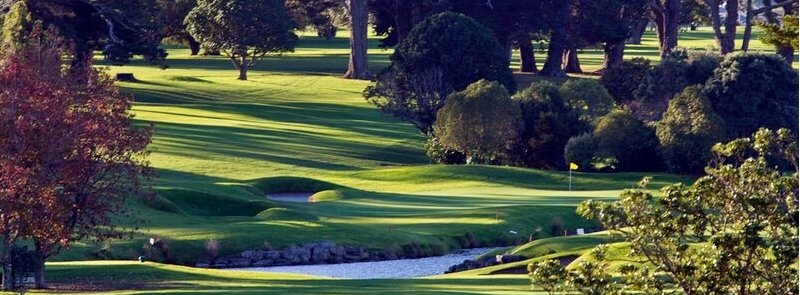
Akarana’s beginnings were in the late 1920s when a group of enthusiasts founded the club on the Winstone farm in Mount Roskill. The course has remained on the same site since the club’s formal incorporation in 1927.
There are suggestions that the great course architect of the era Dr Alister McKenzie may have run an eye over the site when he visited New Zealand and Australia in 1927 after finishing his work at Royal Melbourne and playing a part in the layout of Titirangi.
However what Dr McKenzie may or may not have advised has been enhanced by one his disciples Chris Pitman in the three new holes he built for Akarana in 2003.
The evolving course layout based on the Master Plan by Chris Pitman
The course has never been one of great length nor does the club own much land in Auckland’s bustling inner west so the great feature of Akarana has always been its compactness.
The club’s land has been further encroached upon with Transit New Zealand planning to build the extension of State Highway 20 through what was the old second tee, the back of the first green and the practice fairway. What was supposed to be underway in 2002 finally got under way in 2006 – the club has been proactive with Transit and completed a fine course and clubhouse redevelopment in 2003.
Akarana now has two distinct nines. The shorter inner loop with a par of 34 has one of the great holes in Auckland golf, the par three 8th which measures 176 metres from the blue tee to a narrow green with bunkers on the left and water on the right.
The longer outer nine, which has out of bounds on the left of six holes, has the two longer par fives, two demanding par fours in the 13th and 15th, the testing par three 16th and an exciting short par 4 to finish which produces many birdies.
The full layout measures around 5800 metres from the back tees but the course rating is over par at 70.6 and the slope is 124.
Since the new layout was brought into play in December 2003, the best score on the championship course, without placing, is just four under par, a 66 from Joon Sang Chung from Redwood Park in the final round of the 2005 Auckland Anniversary Championships.
The new layout and the condition of the course drew high praise from many visitors during 2004 including Bob Glading, the former New Zealand Open and PGA champion who was a guest of the club for the Dewar Cup in December. The club was delighted that Bob took the time to write the club after his day at Akarana and was very praiseworthy of the new look layout.
Akarana has featured some of the great names in Auckland golf during its 78 years. One of the most famous was Jim Bissett, after whom the premier interclub competition trophy is named.
The most prolific club champion has been Vic Pirihi, whose 12 victories started in the 1970s and were very nearly added to as recently as 2001 when he lost the final. The Pirihi name remains one of Akarana’s most famous. Vic, at the age of 68, is still a regular, still competitive and has been close to shooting his age in recent weeks. He was a member of the New Zealand Seniors team (over 55) to the Asia Pacific Masters in Singapore last year. His son Mark has also been a club champion, Auckland’s Champion of Champions and a provincial representative, while another son Carl is a member too.
Akarana now has the largest ‘Business Women’s’ membership in Auckland, who together with busy Weekday and Nine Hole sections have all contributed to competitive success in the Auckland district. Noteable women who have represented Auckland in golf include; Polly King (12 times club champion), Rae Riggir, Alison Odlin, Anne Familton, and Marilyn Storey. Akarana is well represented in Auckland competitions – A & B Pennants, Business Women’s Pennants, Betty Faesen, and Nine Hole. One of our premier Auckland tournaments is the Pimms Cup played over 36 holes. The Auckland Anniversary tournament (played over 54 holes) and the Akarana Charles Tour (played over 72 holes) attract some of New Zealands top amateur and professional women.
Among those to have achieved national honours are P.G.F (Pax) Smith who was a national amateur champion in the 1930s and Bruce Rafferty, a four time club champion and one time professional, who was in the New Zealand amateur team in 1967.
